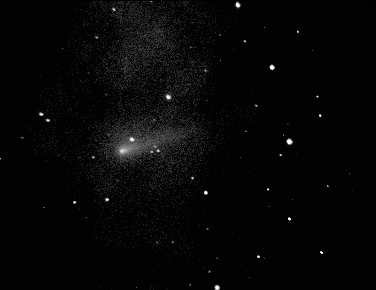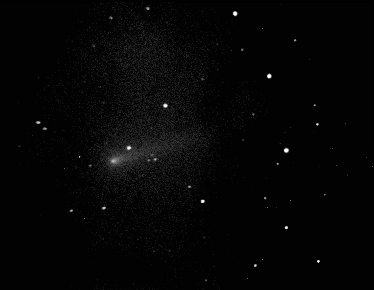

Comet ISON has been predicted to become very bright after perihelion passage in late November 2013. It will pass very close to the Sun, so it seems to me that there is a danger it will break up, so I hoped to image it before it got there. I had my first opportunity on the morning of 24th October. The comet was still very faint and at first I was doubtful if I had indeed captured it. However with excessive processing I managed to extract an image that looks like a fussy object with a tail. This is the first image below.

|
This picture was taken with my MX716 camera attached to my LX200 with focal reducer fitted. This gives me f/3.3, the lowest f number I can achieve with a large aperture. It is a single exposure, enhanced with star_mx7's black-background, and nonlinear-stretch tools. The "smoke" that appears to rise from the comet is the remnants of a bigger area of fogging, caused, I am sure, by local pollution, which was gradually removed by repeated use of the black-background tool. Maybe the tail, stretching to the right just above the small triangle of stars, is wishful thinking but north is at the top of this picture and the comet was in the eastern sky, so is at least roughly in the right direction. But is it the comet? See below. Date and Time: 24th October 2013 05:17 UT Camera: MX716 Telescope: LX200 with 0.33 focal reducer Capture: star_mx7 Processing: star_mx7. Background subtraction, non-linear stretch factor 25, repeated background subtraction until no further improvement. Dark-frame subtraction in my own software. |

|
I had hoped to take a picture of this area again a few nights later to see if this fuzzy object had moved, but the nephalae* decreed otherwise. However I did have a series of 10 pictures taken at 1-minute intervals through a CLS filter that did not yield a better picture than that above. The picture on the left is the earlier picture and if you move your mouse pointer over the image you will see the one taken 9 minutes later. The fuzzy object had moved. Only a close object moving at speed would move this much in 9 minutes. It has to be a comet. Look at the direction the comet has moved; it is dropping towards the Sun, and its tail will be pointing away from the Sun so appears to trail behind it. So my seeing a tail may not be wishful thinking after all…. Date and Time: 24th October 2013 05:28 and 05:37 UT Camera: MX716 Telescope: LX200 with 0.33 focal reducer Capture: star_mx7 Processing: star_mx7. Background subtraction, non-linear stretch factor 25, repeated background subtraction until no further improvement. Dark-frame subtraction in my own software. |